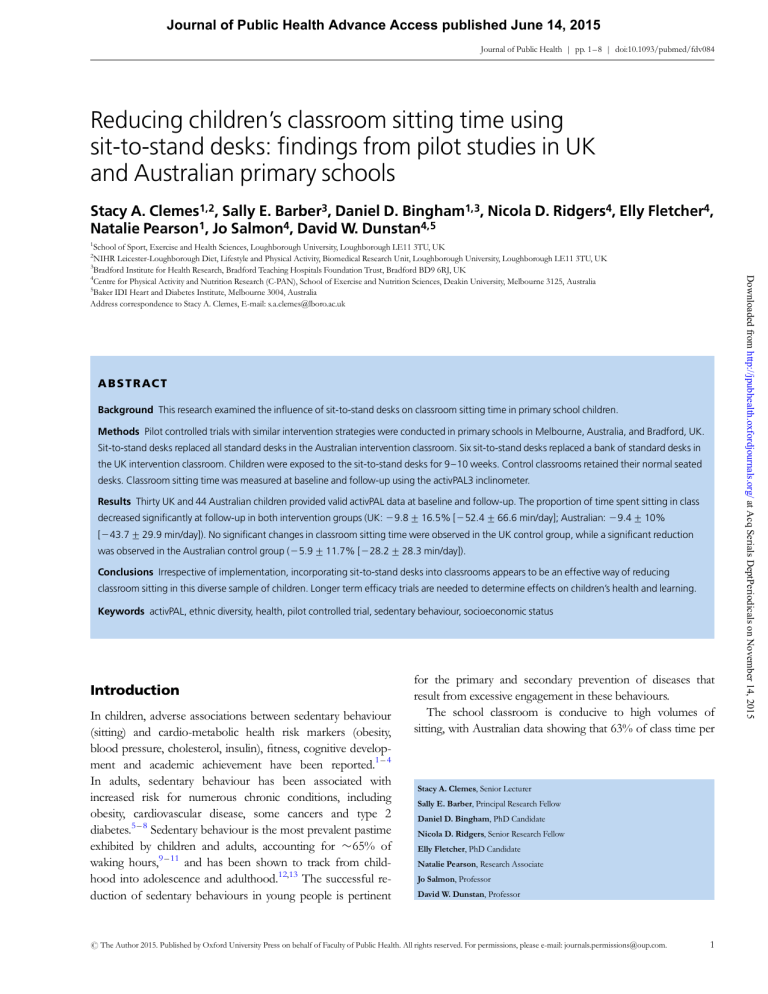Sit-to-Stand Desks: Reducing Sitting Time in Primary Schools
advertisement

Journal of Public Health Advance Access published June 14, 2015 Journal of Public Health | pp. 1–8 | doi:10.1093/pubmed/fdv084 Reducing children’s classroom sitting time using sit-to-stand desks: findings from pilot studies in UK and Australian primary schools Stacy A. Clemes1,2, Sally E. Barber3, Daniel D. Bingham1,3, Nicola D. Ridgers4, Elly Fletcher4, Natalie Pearson1, Jo Salmon4, David W. Dunstan4,5 1 School of Sport, Exercise and Health Sciences, Loughborough University, Loughborough LE11 3TU, UK NIHR Leicester-Loughborough Diet, Lifestyle and Physical Activity, Biomedical Research Unit, Loughborough University, Loughborough LE11 3TU, UK 3 Bradford Institute for Health Research, Bradford Teaching Hospitals Foundation Trust, Bradford BD9 6RJ, UK 4 Centre for Physical Activity and Nutrition Research (C-PAN), School of Exercise and Nutrition Sciences, Deakin University, Melbourne 3125, Australia 5 Baker IDI Heart and Diabetes Institute, Melbourne 3004, Australia Address correspondence to Stacy A. Clemes, E-mail: s.a.clemes@lboro.ac.uk 2 Background This research examined the influence of sit-to-stand desks on classroom sitting time in primary school children. Methods Pilot controlled trials with similar intervention strategies were conducted in primary schools in Melbourne, Australia, and Bradford, UK. Sit-to-stand desks replaced all standard desks in the Australian intervention classroom. Six sit-to-stand desks replaced a bank of standard desks in the UK intervention classroom. Children were exposed to the sit-to-stand desks for 9–10 weeks. Control classrooms retained their normal seated desks. Classroom sitting time was measured at baseline and follow-up using the activPAL3 inclinometer. Results Thirty UK and 44 Australian children provided valid activPAL data at baseline and follow-up. The proportion of time spent sitting in class decreased significantly at follow-up in both intervention groups (UK: 29.8 + 16.5% [252.4 + 66.6 min/day]; Australian: 29.4 + 10% [243.7 + 29.9 min/day]). No significant changes in classroom sitting time were observed in the UK control group, while a significant reduction was observed in the Australian control group (25.9 + 11.7% [228.2 + 28.3 min/day]). Conclusions Irrespective of implementation, incorporating sit-to-stand desks into classrooms appears to be an effective way of reducing classroom sitting in this diverse sample of children. Longer term efficacy trials are needed to determine effects on children’s health and learning. Keywords activPAL, ethnic diversity, health, pilot controlled trial, sedentary behaviour, socioeconomic status Introduction In children, adverse associations between sedentary behaviour (sitting) and cardio-metabolic health risk markers (obesity, blood pressure, cholesterol, insulin), fitness, cognitive development and academic achievement have been reported.1 – 4 In adults, sedentary behaviour has been associated with increased risk for numerous chronic conditions, including obesity, cardiovascular disease, some cancers and type 2 diabetes.5 – 8 Sedentary behaviour is the most prevalent pastime exhibited by children and adults, accounting for 65% of waking hours,9 – 11 and has been shown to track from childhood into adolescence and adulthood.12,13 The successful reduction of sedentary behaviours in young people is pertinent for the primary and secondary prevention of diseases that result from excessive engagement in these behaviours. The school classroom is conducive to high volumes of sitting, with Australian data showing that 63% of class time per Stacy A. Clemes, Senior Lecturer Sally E. Barber, Principal Research Fellow Daniel D. Bingham, PhD Candidate Nicola D. Ridgers, Senior Research Fellow Elly Fletcher, PhD Candidate Natalie Pearson, Research Associate Jo Salmon, Professor David W. Dunstan, Professor # The Author 2015. Published by Oxford University Press on behalf of Faculty of Public Health. All rights reserved. For permissions, please e-mail: journals.permissions@oup.com. 1 Downloaded from http://jpubhealth.oxfordjournals.org/ at Acq Serials DeptPeriodicals on November 14, 2015 A B S T R AC T 2 J O U R NA L O F P U B L IC H E A LT H Methods Participants UK study Participants were recruited from an ethnically diverse primary school located in the City of Bradford, England. Bradford has high levels of deprivation and childhood morbidity;23 the school was located in a neighbourhood within the top third for overall deprivation in England. The school contained two classrooms per year group, and in consultation with the Head and Assistant Head Teachers, the Year 5 cohort (9 – 10 year olds) were selected for participation. Evidence suggests that children in Year 5 upwards are active participants in their own learning, making them an optimal target for classroom interventions that may facilitate learning.24 Parents/guardians of Year 5 children received a letter explaining the school was replacing some existing desks within one Year 5 classroom with sit-to-stand desks. The study was approved by the Loughborough University Ethical Advisory committee. Parents/guardians provided written informed consent for their children to participate in the intervention evaluation. Australian study Participants were recruited from a primary school located in a middle-high socioeconomic status (SES) area in Melbourne, Victoria. In consultation with the Principal and senior teachers, two Year 6 (11 –12 year olds) classrooms (out of a possible three) were randomly selected for participation. Parents/guardians of all children from the respective classrooms received a letter explaining that their child’s classroom had a 50% chance of receiving a sit-to-stand desk. Parents returned written informed consent for their children to participate in the intervention evaluation. The study was approved by Deakin Human Ethics Advisory Group-Health and the Department of Education and Early Childhood Development. Interventions In both the UK and Australian studies, one classroom was allocated to the intervention condition while the other was assigned to the control (usual care) condition. UK study The intervention took place during the spring term (January– April 2014). In the intervention classroom, home to 27 students, three standard desks (sitting a total of six children) were replaced with six Ergotron WorkFit-PD sit-to-stand desks (Ergotron Inc., USA, Fig. 1). The teacher rotated the children around the classroom in groups of six according to the specific lesson being taught to ensure that each child was exposed to the sit-to-stand desks once a day for at least 1 h for 9 weeks. The time of day during which each child was exposed to the desks varied over the course of the week and children were informed that they could sit (on stools provided) or stand when using the desks. The intervention teacher received training on desk adjustment. Information on the benefits of reducing sedentary behaviour and classroom sitting time reduction strategies, based on materials adapted from a previous cluster randomized controlled study, were also provided.15 No environmental or other changes were made to the control classroom (home to 28 students), their teacher continued with normal lesson delivery. Australian study The intervention took place during the spring term (September– November 2013). In contrast to the UK study, all standard desks were replaced with Ergotron WorkFit-PD sit-to-stand desks providing all 26 children (and the teacher) with their own desk throughout the 10-week school term (Fig. 1). Standard classroom chairs remained at the desks throughout. Children were initially encouraged to stand for at least one 30-min class per day and to increase this gradually over the 10-week intervention. As in the UK study, the intervention teacher received training on desk use and the same classroom sitting time reduction strategies.15 The control Downloaded from http://jpubhealth.oxfordjournals.org/ at Acq Serials DeptPeriodicals on November 14, 2015 school day is spent sedentary.14 Moreover, children sit for longer during school hours compared with non-school hours on school days.11,14 Due to the contextually driven nature of sedentary behaviour, interventions in children have begun to target reductions in classroom sitting,15 – 21 with initial studies demonstrating the feasibility of incorporating sit-to-stand desks in primary school classrooms.16,20,22 Evidence suggests that the use of sit-to-stand desks in primary schools is effective in increasing energy expenditure17,21 and standing and movement during the school day.18 However, only one study has directly assessed the impact of such interventions on sitting time.16 Hinckson et al. 16 reported a reduction in total daily sitting of 1 h/day in children exposed to sit-to-stand desks at school; however, the specific changes in classroom sitting time were not reported. To date, evidence on the use of sit-to-stand desks in the school environment has largely been restricted to USA and New Zealand samples. The generalizability of these studies to other countries is unclear due to differences in educational systems. This paper reports the findings of two controlled intervention pilot studies conducted in the UK and Australia, which adopted similar intervention strategies, to examine the influence of sit-to-stand desks on primary school children’s classroom sitting time and total school day sitting. R E DU C I NG CH I L D RE N ’S CL A S SRO OM S IT TI N G TI ME U S IN G S IT- TO - S TA N D D ESK S 3 Data management Fig. 1 The sit-to-stand desks located in the intervention classrooms of the UK (top panel) and Australian (lower panel) schools. classroom involved 22 students and had no environmental or other changes, with the teacher continuing their usual lesson delivery. All activPAL data were downloaded using manufacturer proprietary software (activPAL Professional v.7.2.29) in 15-s epochs and processed using a customized Microsoft Excel macro. The number of minutes that children spent sitting, standing and stepping during waking hours (between 6 am and 10 pm) was obtained for each school day (weekend data were omitted due to low compliance). As applied in accelerometer studies, non-wear time was defined as 60 min of consecutive zero accelerometer counts.27 To enable the examination of the influence of the sit-to-stand desks on classroom sitting time, time spent sitting, standing and stepping during class time (based on provided school bell times) were extracted from the daily weekday data. Due to the exploratory nature of the study, children were included in the analyses if they had worn the activPAL for at least 8 h on at least 1 weekday at each time point. Statistical analyses Measurements Identical measurements were taken in both studies at baseline ( prior to desk installation) and at 9 –10 weeks of follow-up (last 2 weeks of school term). All measurements were undertaken in the schools by trained researchers. Children with parental consent self-reported their age and ethnicity (UK study, e.g. White, Asian) or parent’s place of birth (Australian study). Height and weight were directly measured to the nearest 0.1 cm and 0.1 kg, respectively, without shoes, using portable stadiometers (Australian study: Seca model 220; UK study: Leicester Height Measure) and electronic weighing scales (Australian study: Tanita model 1582; UK study: Seca model 887). For both, the average of two measurements was calculated. Children were issued with an activPAL3 accelerometer (PAL Technologies, UK), worn on the thigh for 7 consecutive days, which responds to signals related to gravitational forces Statistical analyses were conducted using SPSS v.22 (SPSS Inc., Chicago, IL, USA). To account for differences in activPAL wear time between baseline and follow-up, and between the intervention and control groups within the UK and Australian studies, the proportions of wear time spent sitting, standing and stepping were calculated for each participant. These data were used in the analyses as opposed to the absolute minute data. The Shapiro– Wilk test confirmed that all data were normally distributed. To examine any differences between the children participating in the two studies, baseline data for the proportion of class time spent sitting, standing and stepping were compared using independent t-tests. The proportions of time spent in each behaviour during class time were compared between the baseline and follow-up periods for the intervention and control groups within each study using paired-samples t-tests. Differences in the proportion Downloaded from http://jpubhealth.oxfordjournals.org/ at Acq Serials DeptPeriodicals on November 14, 2015 and provides information on thigh inclination.25 The activPAL is a valid measure of time spent sitting, standing and walking in children.26 In the UK study, the activPAL was placed within a nitrile sleeve and attached to the leg using a waterproof hypoallergenic medical dressing (BSN Hypafix), enabling participants to wear the device continuously (24 h a day). In the Australian study, the activPAL was placed in an elastic garter and worn on the front of the thigh during all waking hours. Children were asked to complete a daily log book where they reported the times they woke up and went to bed, and any time the activPAL was removed. On Day 8, children returned the activPAL and diary to school where it was collected by a researcher. 4 J O U R NA L O F P U B L IC H E A LT H of time spent sitting, standing and stepping during class time at baseline and follow-up, along with changes in these behaviours, were compared between groups within each study using independent samples t-tests. These analyses were repeated for the proportions of time spent in each behaviour on a whole weekday. Australian study Forty-eight children had parental consent, of which 44 (92%; 19 boys, 25 girls; mean [ + SD] age: 11.6 + 0.5 years, BMI: 19.4 + 3.3 kg/m2) provided valid activPAL data at baseline and follow-up. Just over half (54%) of the sample’s parents were born in Australia. Results Changes in classroom sitting, standing and stepping time Participants At baseline, children from both countries spent 5 h/day in the classroom (not including morning recess and lunch). There were no significant differences in classroom sitting time at baseline between the UK (200 + 48 min/day, 70% of classroom wear time) and Australian (203 + 22 min/day, 69% of classroom wear time) study samples. Table 1 shows the mean minutes, and the proportion of time spent sitting, standing and stepping during class at baseline and follow-up for the intervention and control participants in the two studies. The proportion of time spent sitting in class decreased significantly at follow-up in both intervention Table 1 Sitting, standing and stepping time (mean min/day + SD), along with the proportion of time spent in these behaviours for the UK and Australian sample, measured using the activPAL during class time for the intervention and control groups at baseline and follow-up Intervention class Baseline Control class Follow-up Change Difference Baseline Follow-up Change (P-value)a UK sample Sitting (min) n ¼ 16 210.4 + 34 n ¼ 14 158 + 49.2 252.4 + 66.6 % of wear time 71.8 + 10.6 62 + 15.8 29.8 + 16.5 Standing (min) 58.5 + 25.1 61.3 + 34.3 2.8 + 39.6 % of wear time 20.1 + 8.7 23.5 + 12.5 3.4 + 14.9 Stepping (min) 23.9 + 8.1 38 + 23.5 14.1 + 18.8 % of wear time Difference (P-value)a 0.03 NS 187.4 + 59.1 180.5 + 67.5 68.6 + 20 65.4 + 20.1 23.2 + 30.2 57.8 + 32 57.9 + 34.1 0.1 + 52.8 21.9 + 12.8 22.1 + 26.2 33.8 + 22.7 13.6 + 25.9 24 + 20.8 20.2 + 9.7 26.9 + 91 NS NS 8.2 + 2.8 14.5 + 7.9 6.3 + 6.8 0.002 7.4 + 3.6 12.8 + 8.2 5.4 + 9.1 NS Steps 1654 + 528.9 3024 + 2195 1370 + 1937 0.013 1425 + 663 2588 + 1867 1163 + 2028 NS Wear time (min) 292.7 + 12.2 257.2 + 47.5 235.5 + 50.9 0.014 265.4 + 36.2 272.1 + 37.3 6.7 + 45.2 NS Australian sample Sitting (min) n ¼ 24 n ¼ 20 201.5 + 25.4 157.8 + 19.7 243.7 + 29.9 % of wear time 67.9 + 8.4 58.5 + 8.4 29.4 + 10 Standing (min) 53.7 + 13.3 % of wear time 18.1 + 4.5 26.4 + 7.5 8.3 + 7.6 Stepping (min) 41.4 + 15.5 41.1 + 9.9 20.3 + 15.4 % of wear time 14 + 5.2 72 + 21.6 15.1 + 3 205.3 + 18.3 ,0.001 18.2 + 21.2 ,0.001 177.1 + 22 228.2 + 28.3 70.8 + 5.8 64.8 + 10.8 25.9 + 11.7 43.7 + 7.7 58.2 + 18.1 14.6 + 18.9 15.1 + 2.7 20.7 + 5.9 5.6 + 6.4 41.1 + 11.5 40.9 + 16.7 20.2 + 18.1 0.04 0.001 1.1 + 4.9 NS 14.2 + 3.9 14.5 + 5.6 0.3 + 6.2 NS Steps 3356 + 1264 3213 + 738 2143 + 1245 NS 3318 + 932 3209 + 1296 2109 + 1449 NS Wear time (min) 296.6 + 5.6 270.8 + 20.4 225.8 + 22.2 ,0.001 290 + 7.4 276.1 + 28.1 213.8 + 26.4 0.03 NS, not significant. a Due to variations in wear time between the baseline and follow-up measurement periods, comparisons were made between the proportion of wear time spent sitting, standing and stepping, and not for the absolute minute data. The time spent in these behaviours is provided, however, for information. Downloaded from http://jpubhealth.oxfordjournals.org/ at Acq Serials DeptPeriodicals on November 14, 2015 UK study Fifty-four children had parental consent to participate in the study, of which 30 (56%; 16 boys, 14 girls; mean [ + SD] age: 10.0 + 0.3 years, BMI: 18.3 + 3.2 kg/m2) provided valid activPAL data at baseline and follow-up. Twenty-three per cent self-reported their ethnicity as White, 63% South Asian and 13% mixed ethnicity. There were no significant differences between the compliant and non-compliant participants in terms of age, BMI, sex proportion or the proportions of participants from each ethnic group (P . 0.05). R E DU C I NG CH I L D RE N ’S CL A S SRO OM S IT TI N G TI ME U S IN G S IT- TO - S TA N D D ESK S groups. In the UK intervention group, while there were no significant changes in the proportion of time spent standing in class, there was a significant increase in the proportion of time spent stepping, along with step counts, at follow-up. In the Australian intervention group, a significant increase in the proportion of time spent standing during class was observed, no changes were seen in stepping time. In the UK control group, no significant differences in any behaviour during class time were observed over the intervention period. In the Australian control group, a significant reduction in the proportion of class time spent sitting, and a significant increase in the proportion of class time spent standing was observed. Within the UK and Australian studies, the intervention and control groups did not differ significantly at baseline in terms of the proportion of class time spent sitting, standing or stepping (P . 0.05). In the UK sample, there were no significant differences between the intervention and control groups at follow-up. In the Australian sample, the intervention group spent a significantly lower proportion of time sitting (P ¼ 0.03), and a higher proportion of time standing (P , 0.01) during class time at follow-up in comparison to the control group (Table 1). The changes in behaviours over the intervention period did not differ significantly between the intervention and control groups in either country (P . 0.05). Total weekday sitting, standing and stepping time Table 2 Sitting, standing and stepping time (mean min/day + SD), along with the proportion of time spent in these behaviours for the UK and Australian Intervention class Control class Follow-up Change Difference Baseline Follow-up Change (P-value)a UK sample Sitting (min) n ¼ 16 525.7 + 103.7 280.8 + 103.4 % of wear time 69.1 + 8.3 66.8 + 6.6 22.3 + 10.7 Standing (min) 176.0 + 62.5 160.1 + 40 215.9 + 76.2 Stepping (min) 19.5 + 6 102.1 + 30.2 (P-value)a n ¼ 14 606.5 + 66.4 % of wear time Difference 20.8 + 6 1.3 + 9.1 100.4 + 45.7 21.7 + 48.1 566.1 + 92.6 NS NS 574 + 180.6 7.9 + 199 71.4 + 7.6 69.1 + 14.1 22.3 + 16.8 149.2 + 48.1 151 + 68.4 1.8 + 93.4 18.9 + 5.9 18.8 + 9 77.4 + 30.5 95.1 + 53.9 20.1 + 12.1 NS NS 17.7 + 59.8 % of wear time 11.4 + 2.9 12.5 + 4.4 1.1 + 4.7 NS 9.7 + 3.6 12.1 + 6.9 2.4 + 7.4 NS Steps 7695 + 2378 7776 + 3769 81 + 4223 NS 5974 + 2307 7295 + 4309 1321 + 4712 NS 884.4 + 97.4 785.9 + 131.1 298.5 + 129.9 792.4 + 95.3 819.8 + 131.2 27.4 + 157.1 NS Wear time (min) Australian sample Sitting (min) 498.2 + 80.2 % of wear time 62.1 + 11 Standing (min) 172 + 51.3 n ¼ 20 429.8 + 60.4 59 + 5.7 185 + 39.6 % of wear time 21.3 + 6.1 25.5 + 5.5 Stepping (min) 134.4 + 53.4 113.5 + 29.9 % of wear time Steps Wear time (min) 0.01 n ¼ 24 268.3 + 97.2 23.1 + 11.2 NS 13 + 53.1 4.2 + 7.4 0.01 220.9 + 40.2 16.6 + 6.6 15.5 + 3.4 21.1 + 5.1 11 011 + 4441 9103 + 2348 21908 + 3268 804.4 + 49.6 728.2 + 68.2 276.2 + 59 489.7 + 84.6 435.5 + 81.2 62.4 + 8.5 62.4 + 8.6 152 + 38 145.5 + 34.7 19.4 + 4.6 20.7 + 3.9 142.2 + 39.2 NS 0.01 ,0.001 18.3 + 5.1 11 678 + 3230 783.7 + 65 118 + 44.2 16.9 + 6 254.2 + 115.8 0 + 10.6 NS 26.5 + 35.8 1.4 + 4.4 NS 224.2 + 50.3 21.3 + 7.7 NS 9513 + 3520 22165 + 4238 0.03 698.8 + 88.1 284.9 + 97.4 ,0.001 NS, not significant. a Due to variations in wear time between the baseline and follow-up measurement periods, comparisons were made between the proportion of wear time spent sitting, standing and stepping, and not for the absolute minute data. The time spent in these behaviours is provided however for information. Downloaded from http://jpubhealth.oxfordjournals.org/ at Acq Serials DeptPeriodicals on November 14, 2015 At baseline, the UK study sample spent a significantly higher proportion of time sitting in comparison to the Australian study sample on a school day (70% [588 + 81 min/day] versus 62% [494 + 81 min/day] of waking time, P , 0.001). There were no significant differences in the proportion of time spent standing between the two samples; however, the UK sample spent a significantly lower proportion of time stepping in comparison to the Australian sample (11% [91 + 32 min/day] versus 17% [138 + 47 min/day] of waking time, P , 0.001). In the UK study, the proportion of time spent sitting, standing and stepping did not differ significantly between baseline and follow-up when examined over the course of a whole school day for the intervention and control groups (P . 0.05) (Table 2). In the Australian study, a significant increase in the proportion of time spent standing on a weekday was observed in the intervention group (P , 0.01). No sample, measured using the activPAL on a whole weekday for the intervention and control groups at baseline and follow-up Baseline 5 6 J O U R NA L O F P U B L IC H E A LT H significant changes were seen in any behaviour in the control group (P . 0.05, Table 2). Discussion Main finding of this study What is already known on this topic Sedentary behaviour is the most prevalent health-related behaviour exhibited by children and adults.9 – 11 In children, adverse associations between sedentary behaviour and health have been reported.1 – 4 While optimum reductions in sedentary time in children need to be established, recent data from adults show that reallocating just 30 min of sedentary time per day to light movement is associated with a 2–4% improvement in cardio-metabolic biomarkers.28 The school classroom is conducive to high volumes of sitting.14 Earlier studies have demonstrated the feasibility of incorporating sit-to-stand desks in the classroom environment;16,20,22 however, specific changes in classroom sitting time have not been reported. What this study adds An important practical and novel finding of this research was that similar changes in classroom sitting time were seen in the UK and Australian studies (9.8% [252 min/day] and 9.4% [244 min/day]), despite the differences in desk provision. The similar reductions in classroom sitting between interventions suggest that it may not be necessary to replace all standard desks in a given classroom with sit-to-stand desks and a bank of desks may be sufficient to produce meaningful changes in sedentary behaviour in the classroom. A randomized controlled trial directly comparing these two intervention strategies is required to confirm this finding. Furthermore, the use of the sitting time reduction strategies provided to intervention teachers were not formally evaluated in the present pilot studies, further research will be required to evaluate the effectiveness of sit-to-stand desks on their own and in combination with sitting time reduction strategies. The interventions appeared to have different effects on classroom non-sedentary time. For example, the UK Limitations of this study Limitations of the study include the relatively small sample sizes, the relatively short intervention periods (9 –10 weeks), potential changes in school schedules during baseline and follow-up (although this would be equivalent for the intervention and control groups within each school) and the lack of long-term follow-up. The lower compliance to the activPAL protocol seen in the UK study is also a limitation. Reasons for the differences in compliance could be attributable to differences in SES, sample age and attachment methods between studies. Lastly, in both studies the control groups consisted of children from the same school as the intervention groups. Contamination of the intervention appears to be evident, as seen elsewhere,16 as small reductions in sitting were observed in both control groups. Despite these limitations, strengths of the present study include the ethnically and socioeconomically diverse samples. The UK school was located in a region known for its high levels of deprivation and childhood morbidity.23 Children attending the school represent a range of ethnic groups, with the majority being South Asian. It is widely acknowledged that South Asians living in the UK have an increased risk of Downloaded from http://jpubhealth.oxfordjournals.org/ at Acq Serials DeptPeriodicals on November 14, 2015 This paper reports the findings from two pilot studies conducted in ethnically and socioeconomically diverse samples of primary school children from the UK and Australia, which adopted similar intervention strategies, to examine the influence of sit-to-stand desks on classroom sitting time. Despite differences in desk provision, the intervention groups from both schools exhibited similar significant reductions in the proportion of class time spent sitting. Taken together, these pilot studies add to the limited evidence base on the efficacy of sit-to-stand desks on objectively measured sitting time.16 intervention group demonstrated a significant increase in the proportion of class time spent stepping, which was coupled by a significant increase in step counts. In contrast, the Australian intervention group displayed a significant increase in the proportion of class time spent standing, with no changes in stepping. These findings could partially be attributed to the fact that the UK sample had to move around the classroom to use the sit-to-stand desks. Installing a bank of sit-to-stand desks and rotating children around to them appears to promote movement in class, in addition to reductions in sedentary time, as reported previously.18,21 Overall on a school day, both samples spent a high proportion of time sitting. This was particularly evident in the UK sample who accumulated just under 10 h sitting per day, equivalent to 70% of their waking hours. The Australian children accumulated 8.25 h/day, accounting for 62% of waking hours. Reductions in total daily sitting time were observed in both intervention groups; these changes were not statistically significant; however, the study was not powered to detect significant changes. The present findings, in agreement with others,16 – 18,21 suggest that while the classroom environment is an ideal setting to target reductions in sedentary behaviour and increases in activity, in highly sedentary populations such as the UK sample multi-setting interventions which target both the school and home environment15 may be necessary for reducing overall daily sitting time. R E DU C I NG CH I L D RE N ’S CL A S SRO OM S IT TI N G TI ME U S IN G S IT- TO - S TA N D D ESK S numerous chronic diseases,29 with South Asian children exhibiting a number of elevated risk factors for disease in comparison to White children.30 – 32 In contrast, the Australian study sample was drawn from a middle-high socioeconomic area in Melbourne. These pilot studies suggest that the implementation of sit-to-stand desks is a feasible way of reducing classroom sitting in children from a range of socioeconomic groups, including ethnic minority and high-risk groups. Longer term efficacy trials are needed to confirm these findings and to determine the impact of such interventions on children’s health, cognition and academic achievement. Australian National Health and Medical Research Council Principal Research Fellowship (APP1026216). S.E.B. and D.D.B. are supported by the Healthy Children, Healthy Families Theme of the NIHR CLAHRC Yorkshire and Humber. References 1 Rey-Lopez JP, Vicente-Rodriguez G, Biosca M et al. Sedentary behaviour and obesity development in children and adolescents. Nutr Metab Cardiovasc Dis 2008;18:242 – 51. 2 Marshall SJ, Biddle SJ, Gorely T et al. Relationships between media use, body fatness and physical activity in children and youth: a meta-analysis. Int J Obes Relat Metab Disord 2004;28:1238 – 46. In the UK, the authors gratefully acknowledge the support provided by the teachers at Grove House Primary School: Michael Hayes, Anita Selby, Martyn Yeoman and Hannah Rogers. Arabella Clarke and Noortje Uphoff are also gratefully acknowledged for their support with data collection. In Australia, Mrs Jean Drury provided a kind donation of funding to support the project. This work was also partially supported by an OIS grant from the Victorian State Government. We acknowledge the support provided by the Principal and teachers at the Mont Albert Primary School, Melbourne, Victoria: Sharon Saitlik, Taila Donald, Emily Grant and Leah Stevenson. We thank Carrie Helfman and Bethany Howard for their support with data collection. We also thank David Perry from Peacock Bros for assisting with the installation of the desks. We also acknowledge Eoin O’Connell for the development of the Excel macro. 3 Salmon J, Tremblay MS, Marshall SJ et al. Health risks, correlates, and interventions to reduce sedentary behavior in young people. Am J Prev Med 2011;41:197 – 206. Conflict of interest statement 9 Steele RM, van Sluijs EM, Cassidy A et al. Targeting sedentary time or moderate- and vigorous-intensity activity: independent relations with adiposity in a population-based sample of 10-y-old British children. Am J Clin Nutr 2009;90:1185 – 92. The desks used in both interventions were supplied via an in-kind donation from Ergotron Inc., USA. The company played no role in the study designs, analyses or in the preparation of this manuscript. Funding S.A.C. is supported by the National Institute for Health Research (NIHR) Diet, Lifestyle and Physical Activity Biomedical Research Unit based at University Hospitals of Leicester and Loughborough University. The views expressed are those of the authors and not necessarily those of the NHS, the NIHR or the Department of Health. D.W.D. is supported by an Australian Research Council Future Research Fellowship (FT100100918). N.D.R. is supported by an Australian Research Council Discovery Early Career Researcher Award (DE120101173). J.S. is supported by an 4 Tremblay MS, LeBlanc AG, Kho ME et al. Systematic review of sedentary behaviour and health indicators in school-aged children and youth. Int J Behav Nutr Phys Act 2011;8:98. 5 Hu FB, Li TY, Colditz GA et al. Television watching and other sedentary behaviors in relation to risk of obesity and type 2 diabetes mellitus in women. JAMA 2003;289:1785 – 91. 6 Lynch BM. Sedentary behavior and cancer: a systematic review of the literature and proposed biological mechanisms. Cancer Epidemiol Biomarkers Prev 2010;19:2691 – 709. 7 Wilmot EG, Edwardson CL, Achana FA et al. Sedentary time in adults and the association with diabetes, cardiovascular disease and death: systematic review and meta-analysis. Diabetologia 2012; 55:2895 – 905. 8 Katzmarzyk PT, Church TS, Craig CL et al. Sitting time and mortality from all causes, cardiovascular disease, and cancer. Med Sci Sports Exerc 2009;41:998 – 1005. 10 Clemes SA, O’Connell SE, Edwardson CL. Office workers’ objectively measured sedentary behavior and physical activity during and outside working hours. J Occup Environ Med 2014;56:298– 303. 11 Abbott RA, Straker LM, Mathiassen SE. Patterning of children’s sedentary time at and away from school. Obesity 2013;21:E131 – 3. 12 Biddle SJ, Pearson N, Ross GM et al. Tracking of sedentary behaviours of young people: a systematic review. Prev Med 2010; 51:345– 51. 13 Pearson N, Salmon J, Campbell K et al. Tracking of children’s bodymass index, television viewing and dietary intake over five-years. Prev Med 2011;53:268– 70. 14 Ridgers ND, Salmon J, Ridley K et al. Agreement between activPAL and ActiGraph for assessing children’s sedentary time. Int J Behav Nutr Phys Act 2012;9:15. 15 Salmon J, Arundell L, Hume C et al. A cluster-randomized controlled trial to reduce sedentary behavior and promote physical activity and Downloaded from http://jpubhealth.oxfordjournals.org/ at Acq Serials DeptPeriodicals on November 14, 2015 Acknowledgements 7 8 J O U R NA L O F P U B L IC H E A LT H health of 8– 9 year olds: the Transform-Us! study. BMC Public Health 2011;11:759. 24 Ginsburg H, Opper S. Piaget’s Theory of Intellectual Development. 3rd edn. Englewood Cliffs, NJ: Prentice-Hall, Inc., 1988. 16 Hinckson EA, Aminian S, Ikeda E et al. Acceptability of standing workstations in elementary schools: a pilot study. Prev Med 2013;56:82– 5. 25 Atkin AJ, Gorely T, Clemes SA et al. Methods of measurement in epidemiology: sedentary behaviour. Int J Epidemiol 2012;41:1460 – 71. 17 Benden ME, Blake JJ, Wendel ML et al. The impact of stand-biased desks in classrooms on calorie expenditure in children. Am J Public Health 2011;101:1433 – 6. 18 Lanningham-Foster L, Foster RC, McCrady SK et al. Changing the school environment to increase physical activity in children. Obesity 2008;16:1849– 53. 26 Davies G, Reilly JJ, McGowan AJ et al. Validity, practical utility, and reliability of the activPAL in preschool children. Med Sci Sports Exerc 2012;44:761 – 8. 27 Cain K, Sallis J, Conway T et al. Using accelerometers in youth physical activity studies: a review of methods. J Phys Act Health 2013; 10:437– 50. 28 Buman MP, Winkler EA, Kurka JM et al. Reallocating time to sleep, sedentary behaviors, or active behaviors: associations with cardiovascular disease risk biomarkers, NHANES 2005 – 2006. Am J Epidemiol 2014;179:323– 34. 20 Koepp G, Snedden B, Flynn L et al. Feasibility analysis of standing desks for sixth graders. ICAN 2012;4:89– 92. 29 Misra A, Khurana L, Vikram NK et al. Metabolic syndrome in children: current issues and South Asian perspective. Nutrition 2007;23:895–910. 21 Benden ME, Zhao H, Jeffrey CE et al. The evaluation of the impact of a stand-biased desk on energy expenditure and physical activity for elementary school students. Int J Environ Res Public Health 2014; 11:9361 – 75. 30 Jebb SA, Rennie KL, Cole TJ. Prevalence of overweight and obesity among young people in Great Britain. Public Health Nutr 2004; 7:461 – 5. 22 Blake JJ, Benden ME, Wendel ML. Using stand/sit workstations in classrooms: lessons learned from a pilot study in Texas. J Public Health Manag Pract 2012;18:412– 5. 23 Wright J, Small N, Raynor P et al. Cohort Profile: the Born in Bradford multi-ethnic family cohort study. Int J Epidemiol 2013; 42:978– 91. 31 Whincup PH, Gilg JA, Papacosta O et al. Early evidence of ethnic differences in cardiovascular risk: cross sectional comparison of British South Asian and white children. BMJ 2002;324:635. 32 Whincup PH, Nightingale CM, Owen CG et al. Early emergence of ethnic differences in type 2 diabetes precursors in the UK: the Child Heart and Health Study in England (CHASE Study). PLoS Med 2010;7:e1000263. Downloaded from http://jpubhealth.oxfordjournals.org/ at Acq Serials DeptPeriodicals on November 14, 2015 19 Cardon G, De Clercq D, De Bourdeaudhuij I et al. Sitting habits in elementary schoolchildren: a traditional versus a “Moving school”. Patient Educ Couns 2004;54:133– 42.





